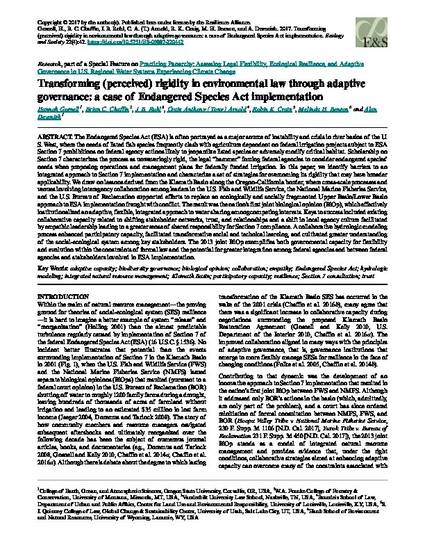
- adaptive capacity,
- biodiversity governance,
- Endangered Species Act,
- hydrologic modeling,
- environmental law
- Environmental Law and
- Law
The Endangered Species Act (ESA) is often portrayed as a major source of instability and crisis in river basins of the U. S. West, where the needs of listed fish species frequently clash with agriculture dependent on federal irrigation projects subject to ESA Section 7 prohibitions on federal agency actions likely to jeopardize listed species or adversely modify critical habitat. Scholarship on Section 7 characterizes the process as unwaveringly rigid, the legal hammer forcing federal agencies to consider endangered species needs when proposing operations and management plans for federally funded irrigation. In this paper, we identify barriers to an integrated approach to Section 7 implementation and characterize a set of strategies for overcoming its rigidity that may have broader applicability. We draw on lessons derived from the Klamath Basin along the Oregon-California border, where cross-scale processes and venues involving interagency collaboration among leaders in the U.S. Fish and Wildlife Service, the National Marine Fisheries Service, and the U.S. Bureau of Reclamation supported efforts to replace an ecologically and socially fragmented Upper Basin/Lower Basin approach to ESA implementation fraught with conflict. The result was the nation's first joint biological opinion (BiOp), which effectively institutionalized an adaptive, flexible, integrated approach to water sharing among competing interests. Keys to success included existing collaborative capacity related to shifting stakeholder networks, trust, and relationships and a shift in local agency culture facilitated by empathic leadership leading to a greater sense of shared responsibility for Section 7 compliance. A collaborative hydrologic modeling process enhanced participatory capacity, facilitated transformative social and technical learning, and cultivated greater understanding of the social-ecological system among key stakeholders. The 2013 joint BiOp exemplifies both governmental capacity for flexibility and evolution within the constraints of formal law and the potential for greater integration among federal agencies and between federal agencies and stakeholders involved in ESA implementation.
Available at: http://works.bepress.com/anthony_arnold/13/
